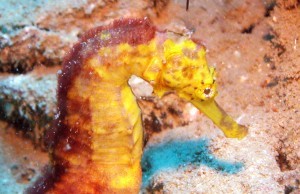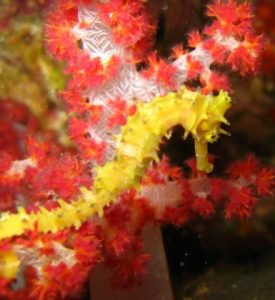Marine Life of Phuket – Sea Horse
The Seahorse is one of the “must see” critters amongst divers in Phuket.
They are found in tropical and temperate waters worldwide often in sheltered areas, for example, sea grass beds, coral reefs and mangroves. Seahorses belong to the fish genus Hippocampus, a name derived from ancient Greek, Hippos meaning horse and Kampos meaning sea monster. The Seahorse has been named for its’ equine profile. Although the seahorse is classified as a bony fish it does not have scales, but has a thin layer of skin that is stretched over a series of bony plates. There are fifty species of Seahorses worldwide ranging in size from 1.5cm to 35cm each having its’ own distinct number of plates.
Seahorses are poor swimmers and are found often resting with their prehensile tail wound round a stationary object. They are territorial with the male staying in a 1m square of their habitat, whereas the female may travel up to 100times that area. All species of Seahorses swim in an upright position with the dorsal fin moving rapidly up to 35 times a second!!! The pectoral fin is positioned behind the eyes and this is used to steer. There is no caudal fin. Each individual has a coronet on the head that is unique to the individual. They also have eyes that move independently.
It is believed that Seahorses mate for life, but there is no data to prove monogamy. However, it is known that a breeding pair will be together for the breeding season. The courtship between the male and female cements the bond between them and is a very important part of the relationship and may take several days. The courtship behavior synchronizes the movements, so when the female is ready she can deposit her eggs into the male brood pouch. One of the unique things about Seahorses is that the male incubates the eggs. The Courtship dance is also known as the “pre-dawn dance” They may change colour, swim side-by-side holding tails and spiral in unison. Once the pair have bonded and the female is ready to transfer her eggs a courtship dance lasting up to 8 hours will take place. During this time the male will pump water into his brood pouch, which is on the ventral or front facing side, expanding it. As the pair drift upwards the female inserts her ovipositor into the male’s pouch depositing her eggs. Once the eggs are transferred the pair sink and the female swims away. The amount of eggs laid depends on the species ranging from 5 to 1500, but the average is 100 to 200.
Once the male has the eggs they are fertilized and are surrounded by a spongy tissue. The pouch acts an incubator and provides oxygen and a controlled environment where the salinity is regulated to prepare the young for life in the sea. By the end of the incubation period the male consumes a third more oxygen than before mating. The female energy expenditure while generating the eggs is twice that of the male during incubation. The gestation period is 2 to 4 weeks during which time the female will visit the male on a daily basis interacting for about 6 minutes. When the fry are formed the male contracts the pouch releasing the young into the water column. The birth normally happens at night allowing the male to receive more eggs from his partner the following morning. Once the young are ejected into the water they are independent as there is no parental care.
It is estimated that less than 0.5% of the fry survive to adulthood. The survival rate is higher compared to other fish due to the protected gestation of the male. It is believed that the male takes the role of incubator because the female takes a long time to produce eggs. This reduces the time between clutches, thus increasing the amount of young. When the eggs are ready they must be transferred to the male’s pouch within a few hours. If this is not possible the eggs are ejected into the water. Once the eggs are laid the female reduces in size. The eggs are equivalent to one third of her body weight!!!
The Seahorse has an unbelievable appetite and eats constantly. It is possible for an individual to eat 3000+ brine shrimp in a day. They will also consume minute fish, crustaceans and plankton.
Unfortunately, there is very little data on Seahorses, so it is impossible to assess the population and whether or not it is endangered. The use of Seahorses in traditional Asian medicine has put pressure on the population as this type of medicine will only use fish from the natural habitat and will not consider individuals from captive breeding. This combined with the deteriorating habitats and souvenir collecting does point to the extinction of some species.
The Seahorse is a prized treasure amongst underwater photographers, as getting the perfect shot can be a challenge due to the coyness of the creature. If you would like to capture “the shot” why not consider doing a Digital Underwater Photography Specialty Course, and now be able to spend more time learning to take the photographs why not take the theory for the Speciality with E learning?








Scubacat Community